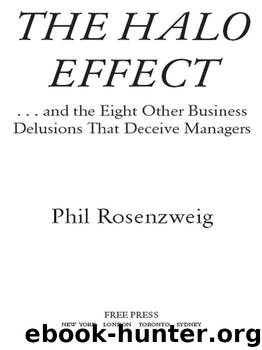The Halo Effect by Rosenzweig Phil

Author:Rosenzweig, Phil [Rosenzweig, Phil]
Language: eng
Format: mobi, epub
Publisher: Free Press
Published: 2007-02-05T16:00:00+00:00
Innovation, observed Joseph Schumpeter, is the basic force that drives market competition in just about every industry — and that holds for the industry of writing business books, as well. The huge success of In Search of Excellence and Built to Last was bound to spawn new competitors eager to tap the market of managers looking for the path to high performance. These new entrants, according to Schumpeter, would try to go beyond the standard set by the first two blockbusters, to offer something different and better, to be even more thorough and authoritative. And that’s exactly what happened. But for all their claims of rigor and scientific precision, these studies got no closer to explaining what really drives company performance — if anything, they repeated some of the delusions we’ve seen so far, and then offered a few more of their own.
One study, called the Evergreen Project, was directed by a McKinsey & Co partner, Bruce Roberson, working with William Joyce at Dartmouth’s Tuck School of Business and Nitin Nohria at Harvard Business School. They began by repeating the most basic of all business questions: “Business is full of mysteries, but none greater than this: What really works?” Companies rise and fall, fads come and go, but “the great question remains unanswered, and not even well asked: What really works?” Well, the authors assured us, help was on the way: “It is time for the first book identifying fundamental practices that create business success — the ones that do indeed really matter.” This book, they declared, was “the world’s most systematic, large scale study of the practices that create business winners. Instead of anecdotal evidence of personal intuition, it is based on a massive research project conducted with scientific rigor and verified by measured fact.” Strong words! And the authors went further. In Search of Excellence was inadequate because it selected its sample based on outcomes, looking only at excellent companies but not comparing them with lesser firms. Built to Last was flawed, too, because it examined a long time period in a single gulp but could not show how actions taken at one moment led to results at a later time. There was no longitudinal dimension, no ability to show temporal causality. This study would do better. The Evergreen Project picked a ten-year period, 1986 to 1996, and then divided it into two blocks of five years. The result wasn’t two categories but four: Companies that performed well in both five-year blocks were called Winners; Climbers were so-so in the first five-year block but showed dramatic improvement in the second; Tumblers did well in the first block but fell back to earth in the second; and Losers did badly in both blocks, racking up ten straight years of bad performance. The idea was to show how actions in the first time period led to better or worse results in the second, to show the causal impact of management decisions. It was a good idea but could work only if the data weren’t shaped by performance — the very thing they were trying to explain.
Download
This site does not store any files on its server. We only index and link to content provided by other sites. Please contact the content providers to delete copyright contents if any and email us, we'll remove relevant links or contents immediately.
| Bookkeeping | Business Mathematics |
| Business Writing | Communications |
| Decision Making | Negotiating |
| Project Management | Running Meetings & Presentations |
| Secretarial Aids & Training | Time Management |
| Training |
Nudge - Improving Decisions about Health, Wealth, and Happiness by Thaler Sunstein(6629)
Deep Work by Cal Newport(5452)
Principles: Life and Work by Ray Dalio(5315)
The Doodle Revolution by Sunni Brown(4034)
Factfulness: Ten Reasons We're Wrong About the World – and Why Things Are Better Than You Think by Hans Rosling(4015)
Thinking in Bets by Annie Duke(3526)
Eat That Frog! by Brian Tracy(3505)
Writing Your Dissertation in Fifteen Minutes a Day by Joan Bolker(3292)
Visual Intelligence by Amy E. Herman(3278)
Hyperfocus by Chris Bailey(3259)
How to win friends and influence people by Dale Carnegie(2819)
How to Win Friends and Influence People in the Digital Age by Dale Carnegie & Associates(2814)
Schaum's Quick Guide to Writing Great Short Stories by Margaret Lucke(2797)
Hidden Persuasion: 33 psychological influence techniques in advertising by Marc Andrews & Matthijs van Leeuwen & Rick van Baaren(2771)
The Pixar Touch by David A. Price(2736)
Ogilvy on Advertising by David Ogilvy(2677)
The Slow Fix: Solve Problems, Work Smarter, and Live Better In a World Addicted to Speed by Carl Honore(2570)
Work Clean by Dan Charnas(2557)
The Content Trap by Bharat Anand(2488)
